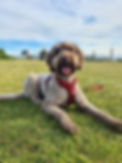HISTORY
OF THE BREED
The Australian Guide Dog Association received an inquiry from a blind lady in Hawaii requesting a guide dog that would not cause her allergies to flare.
The reason she chose Australia was due to the relaxed Quarantine requirements. Because Australia is an island with strict quarantine laws, dogs exported to Hawaii would be able to get off the plane and go straight home with no quarantine.
The Australian Guide Dog Association had nothing to offer, so they set a task to breed such a dog. Their Labradors were tried and proven, so breeding with them was the obvious choice. To achieve a hypoallergenic dog they needed to breed their Labradors to a dog that was already non-shedding, hence they chose the Standard Poodle.
The Guide Dog Association sourced an imported white dog from Sweden, as he was a quality dog from working bloodlines. When the first litter was born, the first dogs were called LABRADor-pOODLE, and so the Labradoodle was born.


Shortly thereafter a couple of breeders went one step further and bred Labradoodle back to a poodle, and Labradoodle to Labradoodle. The main aim at that time was to produce lovely natured family pets, without too much consideration for the non-shedding possibilities.
The Guide Dog Association had minimal success, as they too never recognised the mutated gene that would develop the allergy-friendly Labradoodle as it is seen today. Interest in the Labradoodle soon became apparent, and forward-thinking breeders in Australia started to breed these dogs with a deliberate plan in mind. Within a few short years, other breeders joined in, and together they developed the Australian Labradoodle we all know and love today.
The main attraction to the Australian Labradoodle was the low and non-shedding coats, but more and more people were overcome by the wonderful disposition and kindness the Labradoodle possessed. These dogs were becoming so versatile. Their intelligence and tenacity started to attract people and trainers’ wanting special dogs for sports and assistance/therapy dogs.
Today, we observe the Australian Labradoodle globally as-
-
an allergy-friendly soul mate, family companion,
-
seizure alert dog,
-
agility dog,
-
assistance dog to those with physical, emotional and mental challenges.
The ALA was born to be a guardian over this new developing breed, to bring together breeders from around the world to unite their breeding programs, to breed for the same goals: “An all-round great dog that is non-shedding and allergy-friendly”.
The Australian Labradoodle now comes in various colours, from black, silver and cream, to reds, chocolates and merles. They have also adopted their poodle ancestor’s size variation from A Standard who is over 53cms; a Medium who is not more than 52cms and over 43cms; and a Miniature who is
35-42cms.
There are two coat types that are considered allergy-friendly. These are the Fleece coat, which has a soft textured fleecy feeling. The two variations are wavy fleece and curly fleece. Then there is the Wool coat. This has a definite dense wool feel and is mild to very curly. The last coat type still seen today is the Hair coat. It too varies from short wiry to the long combination. These Hair coats may soon be a thing of the past, but for now, they still play an essential part in the breeding and development of the fleece coat.
By the time the Australian Labradoodle becomes a recognised breed, they will be a dog of three sizes with two coat types. We hope you have enjoyed learning about the Australian Labradoodle, and we invite you to return to this site and watch the progress of this great breed.
